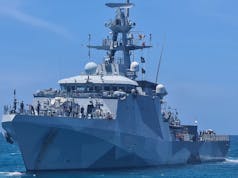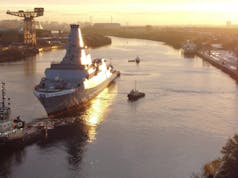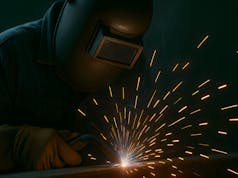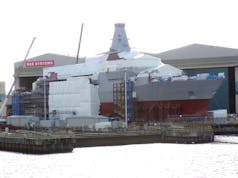It has been revealed that only 6% of the steel used in the Queen Elizabeth class came from overseas.
Over the years, the project has involved a number of production teams, including research and development, technical and production staff from five UK sites and mills.
Alongside the mills, technical and supply chain experts worked closely with BAE to provide more than 90% of the metal used in the build. Tata also worked closely with key suppliers including the UK’s leading independent service centre for the shipbuilding industry, Dent Steel.
Tata supplied material used in everything from the hull of the ship to the 130 tonne ski jump. Tata Steel also developed three new steel grades, FH36, EH46 and ‘Install Plus’. The new grades are lighter and stronger than previous types and allow the Queen Elizabeth class to use less fuel.
A Ministry of Defence spokesperson said:
“94% of the steel used to build the two aircraft carriers that this government is bringing into service came from UK mills. The rest was specialist steel which could not be sourced here in the UK.”
A Government spokesperson said:
“No-one should be in any doubt that – across all of Government’s major procurements – we are working hard to make sure that wherever possible, British suppliers have a fighting chance of competing for and winning contracts. UK suppliers have provided significant quantities of steel for major defence equipment procurement programmes and new government guidelines will help UK steel suppliers to compete effectively with international suppliers for major projects, including those in defence.”
The Queen Elizabeth class mark a change from expressing carrier power in terms of number of aircraft carried, to the number of sortie’s that can be generated from the deck. The class are not the largest class of carrier in the world but they are most likely the smallest and least expensive carrier the Royal Navy could build which still have the advantages that large carriers offer.
Crew move aboard the first carrier in May 2016, sea trials begin in the New Year and Queen Elizabeth moves to Portsmouth in 2017.













Stop sharing facts, dude.
Good, but that should be 100%.
The other percent could be for technical reasons. I.e a sort we cannot produce. I’m no expert though just a guess.
A Ministry of Defence spokesperson said:
94% of the steel used to build the two aircraft carriers that this government is bringing into service came from UK mills. The rest was specialist steel which could not be sourced here in the UK.
Also it could be that the mills were running at economic capacity.
That is, if they made any more (by hiring more people or buying new machinery, or could not secure raw materials over the long term) then they would lose money in the expansion.
Sometimes there are very sound reasons for not accepting orders that sound great but only short term.
But joined up and well though out economic thinking are beyond most sub-eds, some journos and a fair few politicians.
Not TATA steel mills then I take it…?
Sadly the plate mills at Dalzell, Scunthorpe and my plant at Clydebridge who supplied the plates all closed last Friday.
That’s great as far as it goes but I bet we could not manage a repeat order now our steel industry has been allowed to be taken over by foreign interests who are busy closing them down.
No strategic planning.
C A Moron and his merry band of idiots don’t understand what strategic means!
Labour were already closing them down and sold them off long before Cameron came into power.
In 1997 the UK produced 18.3 million tonnes of crude steel, according to the ISSB, and 18.5 million tonnes according to trade body UK Steel. Both bodies agree that by 2010 the figure had fallen to 9.7 million tonnes. So it very nearly halved. It reached 12 million tonnes in 2014.
Employment in the industry fell from 35,000 in 1997 to 19,000 in 2010, according to the ISSB. That’s not quite a halving. By 2014 it had fallen to 18,000
What was that about ‘strategic planning’?
So where is the steel for the Type 26 Global Combat Ship coming from?
That is great news! Thank you
Glad that the UK steel industry is benefiting from new RN vessels also, but it’s typical that others like the Mirror for example will hold on to the 6% from China, and forget that 94% is solely British!
OMG…. 6% of the carriers steel isn’t UK sourced!!!!11!!!1!!!1!!!
… How long before that becomes a stupid red top headline?
Was the 6% steel from overseas armour plate?
Good news.
I bet the specialist grades came from Sweden, Germany or Switzerland. They are the technical steel centres in Europe, and they are really pushing the boundaries of what is possible. I doubt any of it went to China